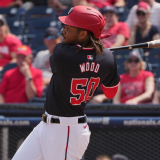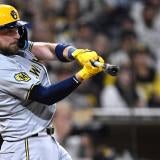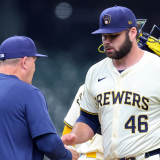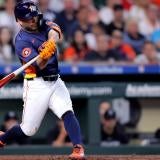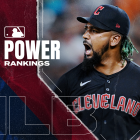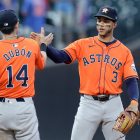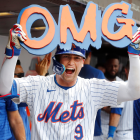On March 22 at Dodger Stadium, the 2017 World Baseball Classic champions will be crowned. The tournament thus far has been enthralling, with many close games and miraculous comebacks, and very few lopsided contests. Here is the full WBC schedule. If you haven’t been paying attention, I recommend starting now.
As with any event like this, the 2017 WBC has taught us some things about baseball. Some big picture stuff and some stuff that is a little smaller in scope. Here are eight things we’ve learned during the WBC so far.
1. The U.S. may not care, but the rest of the world does.
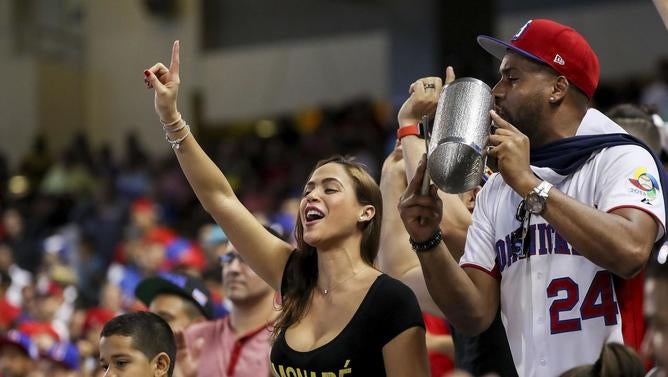
American apathy is a real thing. Fans of Team USA just aren’t into the WBC, it seems. The crowds in round one reflect that. Here was an all-star team of big leaguers -- no, the very best players aren’t participating in the WBC, but the USA roster is still plenty good enough to win -- that couldn’t pack a stadium. This is the fourth WBC, and at this point it’s fair to say USA fans just aren’t into it. And that’s okay. It’s a free country. You can like and dislike whatever you want.
USA fans are alone, however. Folks around the world are into the WBC. The other host countries (Japan, Mexico, South Korea) have drawn well, especially when the home team plays, and fans of the Dominican Republic took over Marlins Park each time they played. Remember, this is not a USA event. This is a global event, and fans around the world sure do seem to care about the WBC a heck of a lot more than USA fans. In that sense, the WBC is doing exactly what it is intended to do: grow the game globally.
2. It’s okay to show emotion on the field.
You know what has made the WBC fun? The players being into it. Big hits bring fist pumps and points to the dugout, home runs are admired and bats are flipped, and clutch strikeouts and defensive plays are met with big high-fives as players run off the field. It’s a joy to watch and the fans feed off that. We’ve seen some tremendous atmospheres during the WBC, especially when Latin American teams are involved.
In MLB, nearly every show of emotion gets shouted down. Flipped your bat after hitting a homer? Sorry son, you can’t show up the pitcher. The pitcher pumps his fist after a big strikeout? Act like you’ve been there before, buddy. It’s terrible. American baseball is so uptight and the WBC gives fans a chance to see how the other side lives. And guess what? They have a heck of a lot more fun. And that’s what baseball should be. Fun. It’s a game.
MLB could learn something from the WBC. If you want to cultivate young fans -- MLB is desperately trying to do this -- then maybe encourage the emotion and let players be themselves. Because I’ve got news for you, no kid is going to be drawn to baseball by watching a player put his head down and jog around the bases after hitting a homer.

3. The extra innings rule is even worse than it sounds.
A few weeks ago word go out MLB will test a radical new extra innings rule in the minors. They want to shorten games and avoid overworking pitchers, and to do that, each extra half-inning will start with a runner on second base. Thankfully, commissioner Rob Manfred confirmed this is being considered for the minors only. Not MLB.
The WBC has a similar extra innings rule -- after the 10th inning, each half-inning starts with runners on first and second -- and my goodness, it’s terrible. For starters, it feels like the road team has the advantage because they bat in the top half of the inning, which means the home team is immediately on the defensive. Secondly, it completely destroys the flow of the game. Extra-inning games have a certain level of suspense and tension. This rule ruins that.
We saw these extra innings rules in action twice over the weekend (Netherlands vs. Japan, Dominican Republic vs. Colombia) and I hope to never see them again. Don’t get me wrong, I understand why they exist. They don’t want to overwork pitchers in the WBC, ditto in the minors, and that’s a good thing. But geez, let’s hope this never ever comes to MLB. It is way to gimmicky.
4. The lack of instant replay is refreshing.
During the first and second rounds of the WBC, the only instant replay available is for home runs, and it can only be initiated by the umpire crew. There are no manager’s challenges. That will change in the semi-finals and finals. Those rounds will be played with MLB replay rules, meaning challenges and all that.
I have to say, there has been something very refreshing about watching baseball without replay. After a close play happens, the umpire makes the call ... and that’s it. There’s no looking at the dugout to see if the manager will challenge, no waiting around, nothing like that. The call gets made, one side inevitably throws up their hands in disagreement, and the game continues. That’s all.
Now, that said, I’m glad MLB has replay because I believe getting the call right is the most important thing. And I don’t expect the league to eliminate replay anytime soon (or ever). Can they tweak the system to make it better? Sure, but it’s not going away. But for these last few days, it’s been nice to watch WBC games the old school way, without replay. The game moves along at a nice pace.
5. Colombia is an emerging baseball power.

Although Colombia went 1-2 in round one and was eliminated -- they pushed heavily favored USA and the Dominican Republic to extra innings in their two losses -- the country is very clearly beginning to emerge as a baseball power. Their lineup did not feature a single established big leaguer, though it included several legitimate prospects like catcher Jorge Alfaro (Phillies), outfielder Tito Polo (Yankees), and third baseman Giovanny Urshela (Indians). The same goes for the pitching staff, as guys like Tayron Guerrero (Marlins) and Nabil Crismatt (Mets) opened eyes.
By any measure, the two best baseball players to ever come out of Colombia are Edgar Renteria and Orlando Cabrera. The country now has two bona fide ace caliber pitchers in the big leagues -- White Sox lefty Jose Quintana and Braves righty Julio Teheran, who formed the WBC’s best 1-2 rotation punch -- with much more young talent on the way. And don’t sleep on the coaches either. They were very willing to think outside the box during the WBC, such as when they continually flip-flopped middle infielders Donovan Solano and Adrian Sanchez to make sure the superior defender would be positioned where the batter was most likely to hit the ball.
Solano and Sanchez keep swapping positions to make sure the better defender is where the batter hits the ball most often. pic.twitter.com/khxzFL5bWa
— Mike Axisa (@mikeaxisa) March 10, 2017
With Renteria and Cabrera retired, Quintana and Teheran are Colombia’s best big league players, and youngsters like Alfaro and Polo and Urshela represent the next wave. Colombia still has a ways to go before they’re on the same level as, say, the Dominican Republic and Venezuela, but the country is starting to develop some great baseball talent and baseball minds.
6. Andreoli may be this year’s Chris Colabello.
Back in 2013, then Twins minor leaguer Chris Colabello opened some eyes with a strong WBC performance, hitting .333/.368/.667 with two home runs in five games for Italy. He drove in seven runs. Later that year Colabello, then 29, received his first big league call-up, and he’s spent parts of each of the last four seasons in the show. The strong WBC performance helped him get his foot in the door.
This year Cubs farmhand John Andreoli, Colabello’s teammate on Team Italy, may be that longtime minor leaguer who parlays a strong WBC performance into his first MLB call-up. Andreoli, 26, hit .316/.350/.842 with three home runs in Italy’s four games. He drove in seven runs. His solo home run against Venezuela on Monday night would have been the game-winner had Italy’s bullpen not blown it.
Andreoli has spent the last two seasons in Triple-A with the Cubs, hitting .256/.374/.396 with 12 home runs and 43 stolen bases in 140 games in 2016. As with Colabello four years ago, Andreoli is not a budding star or anything like that. He’s a potentially useful player with some power and speed, plus the ability to play all three outfield spots and play them well.
The Cubs are loaded and have no room on their roster for Andreoli, but a club in need of a cheap fourth outfielder may have seen enough from him last year and in the WBC to pursue a trade. With any luck, Andreoli’s dominant WBC performance will help get him to the big leagues like it did Colabello in 2013.
7. Gagne just may have something left.
Earlier this month we learned former Cy Young award winner Eric Gagne is considering making a comeback. He hasn’t pitched in MLB since 2008 -- he was one and done on the 2014 Hall of Fame ballot -- but he has thrown in independent leagues here and there over the years. Gagne pitched for Canada in the WBC and made one appearance, allowing one hit and one walk in 2 1/3 scoreless innings. He struck out two.
More important that the results is the stuff. PitchFX says Gagne’s fastball averaged 92.1 mph and topped out at 94.2 mph in his outing, and when he threw his trademark split-changeup, hitters swung and missed half the time. Teams only got one look at Gagne in the WBC -- once the game against USA got out of hand Sunday, I thought Canada would let Gagne pitch just to showcase him to MLB teams one more time, but alas -- but it was a good look. Others like Ryan Dempster and Bruce Chen didn’t look so hot as they came out of retirement for the WBC.
Will a club sign Gagne? Who knows. Teams are always looking for bullpen help and former star closers have a way of getting opportunity after opportunity. I could see a team giving Gagne a minor league deal that is essentially an extended audition. Do well in these final three weeks of spring training and we’ll see where we stand when the regular season arrives. That sort of thing. For now, what Gagne did in his lone WBC appearance was enough to show teams he’s not washed up. There just might be something left in the tank.
8. Thorn and Mota are an elite broadcasting tandem.
Gary Thorne, the Orioles lead play-by-play man for MASN, and Jose Mota, Spanish radio analyst for the Angels on KWKW, were paired together on MLB Network’s broadcasts of Pool D in Mexico, and my gosh, they were tremendous. Thorne is an excellent play-by-play man who knows when to let the game flow and when to ramp up the excitement -- he also has a great home run call (“Goodbye home run!”) he was able to use quite often in the WBC considering 37 more runs were scored in Pool D than any other first round pool this year -- while Mota brings insight as an ex-player.
Thorne and Mota complemented each other very well during the broadcasts. They could talk about the game intelligently, dive into some advanced stats without making your brain explode, and make you laugh as well. Their chemistry was top notch. Pool D was the most exciting first round pool because there were so many incredible comebacks and high-scoring games -- Estadio Charros de Jalisco is at altitude, so it’s essentially Coors Field south of the border -- and Thorne and Mota made the games that much more enjoyable. Hopefully they get paired up again at some point in the future.



